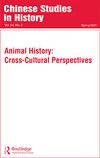CHINESE GRAND STRATEGY IMPLEMENTATION AFTER 1990: GOALS, TOOLS, PHASES
IF 0.2
4区 历史学
0 ASIAN STUDIES
引用次数: 0
Abstract
This article is the second part on the issue of China’s Grand Strategy. It reveals the dramatic shift in the country’s grand strategy under Xi Jinping’s leadership, namely from 2017. Now it’s crucial to move away from the obsolete understanding of China. Beijing’s consideration comes through the lens of Chinese own geostrategic clash with the USA over global leadership, launched by China after 1990. Despite increased cooperation with the USA during Deng Xiaoping rule, Beijing perceived America as the competitor. Especially after the USSR collapse, US-encouraged efforts to “liberalize” China in 1989 and Gulf War in the Middle East, which convinced Beijing of the American determination to sustain its hegemony by hard force. Chinese Grand Strategy has its goals, tools – political, economic, military means, and three main phases: blunting, building, expansion. All of them are in detail scrutinized in this paper. Against the background of the Russo-Ukrainian war, Beijing continues to maintain a “neutral” stance and promotes its own vision of ceasefire. China is interested in the end of the war, but it is vital for Beijing if Russo-Ukrainian confrontation result will lead to the strengthening of Russia-China asymmetrical strategic partnership, development of Beijingled regional alliances in Eurasia, and increase of Chinese global influence.1990年后中国大战略实施:目标、工具、阶段
本文是关于中国大战略问题的第二部分。现在至关重要的是要摆脱对中国过时的理解。北京的考虑是通过中国自己与美国在1990年后发起的全球领导地位的地缘战略冲突的镜头来考虑的。特别是在苏联解体后,1989年美国鼓励中国“自由化”的努力,以及中东的海湾战争,使北京确信美国决心用强硬的武力维持其霸权。中国的大战略有其目标、工具——政治、经济、军事手段,以及三个主要阶段:钝化、建设、扩张。本文对所有这些都进行了详细的研究。在俄乌战争的背景下,北京继续保持“中立”立场,推进自己的停火愿景。中国对战争的结束感兴趣,但如果俄乌对抗的结果将导致中俄不对称战略伙伴关系的加强,北京主导的欧亚地区联盟的发展,以及中国全球影响力的增加,对北京来说是至关重要的。
本文章由计算机程序翻译,如有差异,请以英文原文为准。
求助全文
约1分钟内获得全文
求助全文
来源期刊

CHINESE STUDIES IN HISTORY
Multiple-
CiteScore
0.20
自引率
0.00%
发文量
5
期刊介绍:
Chinese Studies in History makes noteworthy works and important trends of historical study in the Chinese-speaking world available to English-language readers. Thematic issues present original papers or articles from academic journals and anthologies that have been selected for translation because of their excellence, interest, and contribution to scholarship on the topic. Topical coverage ranges over all periods and subfields of Chinese and East Asian history as well as more general theoretical and historiographical questions of interest to historians of many specialties. Each issue includes a substantive introduction by the editor or specialist guest editor.
 求助内容:
求助内容: 应助结果提醒方式:
应助结果提醒方式:


